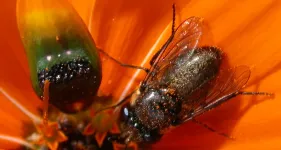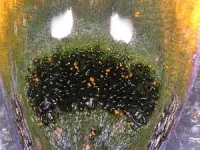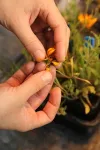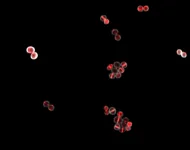(Press-News.org) A male fly approaches a flower, lands on top of what he thinks is a female fly, and jiggles around. He’s trying to mate, but it isn’t quite working. He has another go. Eventually he gives up and buzzes off, unsuccessful. The plant, meanwhile, has got what it wanted: pollen.
A South African daisy, Gorteria diffusa, is the only daisy known to make such a complicated structure resembling a female fly on its petals. The mechanism behind this convincing three-dimensional deception, complete with hairy bumps and white highlights, has intrigued scientists for decades.
Now researchers have identified three sets of genes involved in building the fake fly on the daisy’s petals. The big surprise is that all three sets already have other functions in the plant: one moves iron around, one makes root hairs grow, and one controls when flowers are made.
The study found that the three sets of genes have been brought together in the daisy petals in a new way to build fake lady flies. The ‘iron moving’ genes add iron to the petal’s normally reddish-purple pigments, changing the colour to a more fly-like blue-green. The root hair genes make hairs expand on the petal to give texture. And the third set of genes make the fake flies appear in apparently random positions on the petals.
“This daisy didn’t evolve a new ‘make a fly’ gene. Instead it did something even cleverer - it brought together existing genes, which already do other things in different parts of the plant, to make a complicated spot on the petals that deceives male flies,” said Professor Beverley Glover in the University of Cambridge’s Department of Plant Sciences and Director of the University’s Botanic Garden, senior author of the study.
The researchers say the daisy’s petals give it an evolutionary advantage, by attracting more male flies to pollinate it. The plants grow in a harsh desert environment in South Africa, with only a short rainy season in which to produce flowers, get pollinated, and set seed before they die. This creates intense competition to attract pollinators - and the petals with fake lady flies make the South African daisy stand out from the crowd.
The results are published today in the journal Current Biology.
Compared to most living organisms, the group of plants including the sexually deceptive daisy is very young in evolutionary terms at 1.5 to 2 million years old. The earliest daisies of this family tree didn’t have the fake fly spots, which means they must have appeared on the daisy petals very rapidly.
“We’d expect that something as complex as a fake fly would take a long time to evolve, involving lots of genes and lots of mutations. But actually by bringing together three existing sets of genes it has happened much more quickly,” said Dr Roman Kellenberger, a postdoctoral researcher in the University of Cambridge’s Department of Plant Sciences and first author of the study.
To get their results, the researchers compared which genes were switched on in petals with, and without fake flies in the same type of daisy plant. They also compared these to petals from a different type of daisy that produces a simple spot pattern, to work out which genes were specifically involved in making the daisy’s spots so deceptive.
This is the only example of a flower that produces multiple fake flies on top of its petals. Other members of the daisy family make much simpler spots – for example spots in a ring around all the petals - that aren’t very convincing to real flies. By comparing the different daisies in the family tree, the researchers were able to work out the order that the fake flies came into being: colour first, then random positioning, then texture.
“It’s almost like evolving a whole new organ in a very short time-frame. Male flies don’t stay long on flowers with simple spots, but they’re so convinced by these fake flies that they spend extra time trying to mate, and rub off more pollen onto the flower – helping to pollinate it,” said Kellenberger.
END
Deceptive daisy’s ability to create fake flies explained
2023-03-23
ELSE PRESS RELEASES FROM THIS DATE:
Ancient genomes reveal immunity adaptation in early farmers
2023-03-23
Francis Crick Institute press release
Under strict embargo: 15:00hrs GMT 23 March 2023
Peer reviewed
Observational study
People
Research from the Francis Crick Institute published today in Current Biology has revealed that diversity in genes coding for immunity may have facilitated adaptation to farming lifestyles in prehistoric periods.
Researchers at the Ancient Genomics Laboratory at the Crick studied available genome-wide DNA from 677 individuals dating to Stone Age Europe, spanning the movement of Neolithic farmers from the Near East into Europe about 8000 years ago, where they mixed with Mesolithic hunter-gatherers already in Europe.
They were interested in whether ...
Vaccination halves risk of long COVID, largest study to date shows
2023-03-23
Being vaccinated against Covid halves people’s risk of developing long Covid, according to new research from the University of East Anglia.
Long Covid still affects some two million people in the UK, and new research published today reveals the risk factors associated with developing the condition.
Overweight people, women, smokers and those over the age of 40 are also more likely to suffer from long Covid according to the study - which includes more than 860,000 patients and is thought to be the largest of its kind.
The study also finds that co-morbidities such as asthma, COPD, Type 2 Diabetes, coronary heart disease, immunosuppression, anxiety ...
Risk factors associated with post−COVID-19 condition
2023-03-23
About The Study: This systematic review and meta-analysis of 41 studies including 860,000 patients found that certain demographic characteristics (e.g., age and sex), comorbidities, and severe COVID-19 were associated with an increased risk of post−COVID-19 condition (PCC; also known as long COVID), whereas vaccination had a protective role against developing PCC sequelae. These findings may enable a better understanding of who may develop PCC and provide additional evidence for the benefits of vaccination.
Authors: Vassilios ...
Association of treatment with nirmatrelvir and the risk of post–COVID-19 condition
2023-03-23
About The Study: This cohort study found that in people with SARS-CoV-2 infection who had at least one risk factor for progression to severe disease, treatment with nirmatrelvir within five days of a positive SARS-CoV-2 test result was associated with reduced risk of post−COVID-19 condition (also known as long COVID) across the risk spectrum in this cohort and regardless of vaccination status and history of prior infection. The totality of the findings suggests that treatment with nirmatrelvir ...
Mental distress among female individuals of reproductive age after overturning of Roe v Wade
2023-03-23
About The Study: This case control study found that for female individuals, the loss of abortion rights was associated with a 10% increase in prevalence of mental distress relative to the mean over the three months after the Supreme Court of the U.S. decision. Restricting legal abortion access may be associated with disproportionate outcomes among individuals of lower socioeconomic status and in medically underserved areas, who may experience greater economic and mental health burdens of having unwanted pregnancies due to increased travel costs of obtaining abortions.
Authors: Muzhe Yang, Ph.D., of Lehigh University in Bethlehem, ...
SARS‐CoV‐2 infection during pregnancy linked to higher risk of neurodevelopmental disorders in male infants
2023-03-23
BOSTON – New research led by investigators at Massachusetts General Hospital (MGH), a founding member of Mass General Brigham (MGB), found that males but not females born to mothers with SARS‐CoV‐2 infection during pregnancy were more likely to receive a neurodevelopmental diagnosis in the first 12 months after delivery. The findings are published in JAMA Network Open.
Previous studies have found associations between other infections during pregnancy and increased risk of neurodevelopmental disorders in children, such as autism spectrum disorder, but it’s unclear if such a link exists with SARS‐CoV‐2 infection during pregnancy. To investigate, ...
Sylvester Cancer investigators find disparities in mesothelioma survival due to social determinants, limited access
2023-03-23
MIAMI, FLORIDA (EMBARGOED UNTIL THURSDAY, MARCH 23, 2023, AT 11 A.M. ET) – Treatment outcomes for patients with malignant pleural mesothelioma, a rare cancer commonly known as mesothelioma, are often affected by social determinants of health and overall survival rates could be improved by addressing these health disparities and improving access to specialized care.
That’s the key takeaway from new research published March 23 by investigators at the Sylvester Comprehensive Cancer Center at the University of Miami Miller School of Medicine and collaborators, whose study appears in the journal JAMA Network Open.
“We found that mesothelioma patients who ...
Fat-burning molecule may be promising target for most common childhood brain cancer
2023-03-23
FOR IMMEDIATE RELEASE
Research from Johns Hopkins Kimmel Cancer Center experts revealed a type of RNA, previously considered to be “junk,” that may help doctors distinguish and treat a subgroup of patients with medulloblastoma.
Medulloblastoma is the most common malignant brain tumor in children, accounting for about 20% of all pediatric brain cancers. Four groups of medulloblastomas have been identified, and one is named sonic hedgehog (SHH) because of the spiky, hedgehog-like appearance of fruit flies ...
Blocked cell wall formation stops bacterial cell division
2023-03-23
We still do not understand exactly how antibiotics kill bacteria. However, this understanding is necessary if we want to develop new antibiotics. And that is precisely what is urgently needed, because bacteria are currently showing more and more resistance to existing antibiotics. Therefore, researchers from the University Hospital Bonn (UKB) and the University of Bonn used high-performance microscopes to observe the effect of different antibiotics on the cell division of Staphylococcus aureus. They found that the biosynthesis of peptidoglycan, core component of the bacterial cell wall, is the driving force during the entire process of cell division. In ...
Alliance for Cancer Gene Therapy to honor Dr. Crystal Mackall with Edward Netter Leadership Award
2023-03-23
Alliance for Cancer Gene Therapy (ACGT) will award the Edward Netter Leadership Award to Crystal Mackall, MD, of Stanford University, at the ACGT Awards Luncheon on March 30 at Riverpark restaurant at the Alexandria Center for Life Science, located at 450 E. 29th St., New York City.
Named for ACGT co-founder, Edward Netter, the award recognizes a researcher who has made unparalleled and groundbreaking contributions to the field of cell and gene therapy for cancer. Dr. Mackall is a leader in advancing cell and gene therapies for the treatment of solid tumors, with a major focus on children’s cancers.
In addition to being an ACGT Research ...





